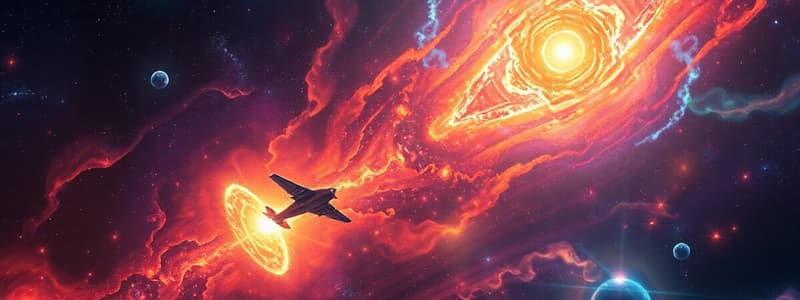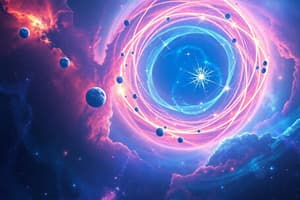Podcast
Questions and Answers
Quina és la proporció aproximada de la densitat total de massa-energia de l'univers que correspon a la matèria fosca?
Quina és la proporció aproximada de la densitat total de massa-energia de l'univers que correspon a la matèria fosca?
- 45%
- 15%
- 27% (correct)
- 68%
Quina és la funció principal dels telescopis de ràdio?
Quina és la funció principal dels telescopis de ràdio?
- Proporcionar imatges de l'espai sense interferència atmosfèrica
- Detectar ones de ràdio emeses per objectes distants (correct)
- Detectar llum visible dels estels
- Mesurar la temperatura de les estrelles
Quina afirmació descriu millor l'energia fosca?
Quina afirmació descriu millor l'energia fosca?
- Un material que absorbeix la llum visible
- Un component que augmenta la gravetat de l'univers
- Un tipus de radiació detectat pels telescopis óptics
- Una força que provoca l'expansió accelerada de l'univers (correct)
Quin és l'objectiu principal de la cosmologia?
Quin és l'objectiu principal de la cosmologia?
Quines dades proporcionen els telescopis espacials respecte als terrestres?
Quines dades proporcionen els telescopis espacials respecte als terrestres?
Quina és l'estimada edat de l'univers?
Quina és l'estimada edat de l'univers?
Què és la matèria fosca?
Què és la matèria fosca?
Quina de les següents és una característica de les galàxies espirals?
Quina de les següents és una característica de les galàxies espirals?
Què passa amb les estrelles quan exhaureixen el seu combustible nuclear?
Què passa amb les estrelles quan exhaureixen el seu combustible nuclear?
Què és la radiació de fons de microones còsmica (CMB)?
Què és la radiació de fons de microones còsmica (CMB)?
Quina de les següents és una característica clau de la teoria del Big Bang?
Quina de les següents és una característica clau de la teoria del Big Bang?
Què és un supercúmul?
Què és un supercúmul?
Què es diferencia dels forats negres dels altres objectes de l'univers?
Què es diferencia dels forats negres dels altres objectes de l'univers?
Flashcards
L'edat de l'univers
L'edat de l'univers
L'univers té aproximadament 13.8 milions d'anys.
Teoria del Big Bang
Teoria del Big Bang
Model que descriu l'origen i l'evolució de l'univers.
Expansió de l'univers
Expansió de l'univers
L'univers s'està expandint amb galàxies allunyant-se.
Composició de l'univers
Composició de l'univers
Signup and view all the flashcards
Galàxies
Galàxies
Signup and view all the flashcards
Cicle de vida de les estrelles
Cicle de vida de les estrelles
Signup and view all the flashcards
Supernova
Supernova
Signup and view all the flashcards
Black holes supermassius
Black holes supermassius
Signup and view all the flashcards
Matèria fosca
Matèria fosca
Signup and view all the flashcards
Energia fosca
Energia fosca
Signup and view all the flashcards
Telescopi radio
Telescopi radio
Signup and view all the flashcards
Cosmologia
Cosmologia
Signup and view all the flashcards
Telescopi espacial
Telescopi espacial
Signup and view all the flashcards
Study Notes
General Characteristics of the Universe
- The universe is vast and largely empty space, filled with various celestial objects like stars, galaxies, and planets.
- It is estimated to be approximately 13.8 billion years old, based on observations of the cosmic microwave background radiation.
- The universe is expanding, with galaxies moving away from each other at accelerating rates. This expansion is attributed to dark energy.
- The composition of the universe is estimated to be approximately 68% dark energy, 27% dark matter, and 5% ordinary matter (atoms).
The Big Bang Theory
- The Big Bang theory is the prevailing cosmological model for the universe's origin and evolution.
- It posits that the universe began from an extremely hot, dense state approximately 13.8 billion years ago and has been expanding and cooling ever since.
- The theory is supported by observations of the cosmic microwave background radiation, the abundance of light elements, and the redshift of distant galaxies.
- The Big Bang theory describes the universe's evolution from the extremely early moments to the present day.
Structure of the Universe
- The universe is not uniform; it contains large-scale structures such as galaxies, galaxy clusters, and superclusters.
- Galaxies are massive collections of stars, gas, dust, and dark matter gravitationally bound together.
- Galaxies come in various shapes, including spiral, elliptical, and irregular galaxies.
- Our own galaxy, the Milky Way, is a spiral galaxy.
- Superclusters are large groups of galaxy clusters.
Galaxies
- Galaxies are held together by gravity.
- Galaxies contain stars, planets, and other celestial objects.
- Galaxies are categorized based on their shape and structure.
- Spiral galaxies have a central bulge and spiral arms.
- Elliptical galaxies are more spherical or oval-shaped.
- Irregular galaxies have no distinct shape.
- Stars within galaxies orbit the galactic center.
- The center of a galaxy often contains a supermassive black hole.
Stars
- Stars are massive spheres of plasma held together by gravity.
- Nuclear fusion reactions in the cores of stars produce energy in the form of light and heat.
- Stars vary in size, temperature, and brightness.
- Stars go through different life cycles, depending on their mass.
- Stars eventually exhaust their nuclear fuel and die.
- The death of massive stars can result in supernova explosions.
Dark Matter and Dark Energy
- Dark matter is a mysterious substance that does not interact with light but exerts gravitational pull.
- It is thought to constitute approximately 27% of the universe's total mass-energy density.
- Dark energy is a mysterious force causing the accelerated expansion of the universe.
- It is thought to compose approximately 68% of the universe's total mass-energy density.
- The nature and properties of both dark matter and dark energy are still largely unknown. Scientists are actively researching them.
Observational Tools in Astronomy
- Telescopes, including ground-based and space-based telescopes, are used to observe celestial objects and collect data about the universe.
- Radio telescopes detect radio waves emitted from distant objects.
- Optical telescopes detect visible light from stars and galaxies.
- Space telescopes provide clearer images of celestial objects by avoiding atmospheric interference.
Cosmology
- Cosmology is the study of the origin, evolution, and large-scale structure of the universe.
- It combines observations of astronomical objects with theoretical models and calculations.
- It seeks to understand the fundamental laws governing the universe.
- Cosmology explores the universe's past, present, and future.
Studying That Suits You
Use AI to generate personalized quizzes and flashcards to suit your learning preferences.




